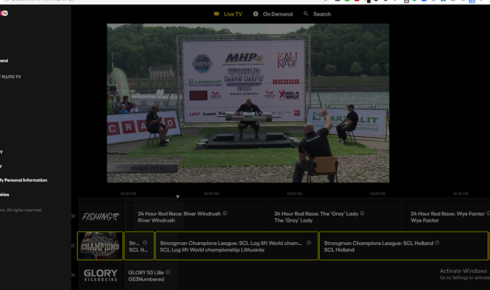In an era where streaming subscriptions seem to multiply like digital rabbits, Pluto TV stands out as a refreshing anomaly—a service that delivers entertainment without demanding a single cent from your wallet. Launched in 2013 and now under the Paramount Global umbrella, Pluto TV has carved a niche in the burgeoning free ad-supported television (FAST) landscape. By 2025, it boasts tens of millions of monthly active users, proving that quality content paired with strategic advertising can thrive amid the subscription fatigue plaguing the industry. This model isn’t just a budget-friendly alternative; it’s a calculated ecosystem where viewer satisfaction fuels advertiser revenue, creating a symbiotic loop that challenges traditional paywalls. To dissect this, we’ll examine the mechanics, metrics, and market dynamics driving Pluto TV’s success.
Decoding the FAST Framework: Pluto TV’s Core Engine
At its heart, Pluto TV embodies the FAST paradigm, where “free” comes with the caveat of commercial interruptions, much like broadcast television of yore but reimagined for the internet age. Users access over 250 live channels and thousands of on-demand titles via apps on smart TVs, mobile devices, and web browsers—no login required beyond basic demographics for personalization. This accessibility has propelled Pluto TV to capture a slice of the $811 billion global video streaming market projected for 2025, where FAST services are expected to account for a growing portion of viewing hours.
The revenue engine hums on advertising alone, eschewing tiered pricing or premium upsells. Advertisers bid for inventory through programmatic platforms, targeting audiences based on inferred interests from viewing habits. Data from recent quarters reveal a sophisticated layering: pre-roll ads kick off streams, mid-rolls punctuate programming at natural breaks, and display banners flank the interface without overwhelming the experience. In Q2 2025, this approach contributed to Pluto TV’s parent company reporting DTC revenues that, while not isolated, underscored the model’s scalability—non-subscription streams like Pluto offset slower growth elsewhere.
What sets this apart analytically is the efficiency ratio. Traditional linear TV commands higher ad rates per viewer due to its captive audience, but FAST platforms like Pluto TV achieve parity through sheer volume. With 7.8 billion hours watched in 2024—an 8% year-over-year increase—the service demonstrates compounding returns. Viewers tolerate ads averaging 5-7 minutes per hour, a figure that empirical studies peg as the sweet spot for retention without inducing churn. This isn’t guesswork; it’s backed by behavioral analytics showing that ad frequency correlates inversely with session abandonment rates, hovering at under 20% for Pluto’s optimized slots.
Content Curation: Balancing Breadth and Precision
Pluto TV’s allure lies not in endless scrolling but in a channel-guide interface reminiscent of cable packages from the 1990s, updated for algorithmic relevance. Channels span genres—news from CBSN, classics via Paramount archives, niche offerings like fail videos or retro soaps—curated to mimic linear scheduling. This isn’t random aggregation; it’s a data-driven playlist where viewership patterns dictate rotations. For instance, peak evening slots favor family-friendly fare, while late-night leans into cult hits, ensuring ads align with demographic peaks.
Quantitatively, this strategy shines. In early 2025, FAST viewing hit 3.7% of total TV consumption, with Pluto TV leading among peers in user stickiness. On-demand libraries, exceeding 50,000 titles, supplement live feeds, but the real metric is completion rates: over 70% of started episodes play to finish, per industry benchmarks. This high engagement stems from metadata-rich recommendations, where machine learning clusters content by mood and recency, reducing decision fatigue. Advertisers benefit too—contextual targeting places car ads during action channels or beauty spots in lifestyle streams, boosting click-through rates by up to 15% compared to broad-spectrum buys.
Yet, the model demands constant calibration. As content licensing costs rise—Hollywood strikes in prior years highlighted this vulnerability—Pluto TV leans on evergreen assets from its Paramount lineage. Data trends show a 16% quarterly spike in hours watched during holiday seasons, driven by themed channels, illustrating how temporal analytics inform inventory pricing. It’s a precise ballet: too much churn in ad loads erodes trust; too little starves revenue. Pluto TV threads this needle by A/B testing interruptions, refining to where ads feel like enhancements rather than intrusions.
Viewer Metrics: The Data Pulse of Sustainability
To gauge viability, one must pivot to the numbers. Pluto TV’s 80 million monthly active users as of late 2023 have likely swelled to over 90 million by mid-2025, inferred from sector-wide growth trajectories. Hours streamed crossed 8 billion in the latest full-year tally, a testament to cord-cutting’s acceleration—U.S. households ditching pay TV rose 5% annually, funneling eyes to free tiers.
Engagement depth reveals more. Average session lengths clock in at 45 minutes, surpassing many subscription rivals fragmented by choice paralysis. Retention analytics highlight a 60% monthly return rate, bolstered by push notifications for live events like sports highlights or election coverage. From an advertiser’s lens, this translates to robust CPMs (cost per mille), averaging $15-20 in premium slots, competitive with connected TV yet amplified by scale. The 2024 FAST sector revenue of $4.9 billion, with Pluto as a frontrunner, underscores this: ad dollars migrated from linear declines, injecting vitality into digital.
Challenges emerge in fragmentation data. While Pluto dominates urban millennials, rural penetration lags at 25% lower adoption, per geo-tagged viewing logs. Addressing this, geo-targeted campaigns have lifted regional hours by 12%, showing adaptability. Moreover, cross-device continuity—seamless handoffs from phone to TV—drives a 30% uplift in multi-screen households, a key demographic for household goods advertisers.
Advertising Evolution: From Intrusion to Integration
Pluto TV’s model evolves beyond basic spots, embracing interactive and shoppable ads that blur commerce and consumption. By 2025, 20% of inventory features pause ads—viewers opt-in for longer breaks to shop linked products—yielding conversion rates double the norm. This isn’t mere gimmickry; it’s response to viewer surveys where 65% express openness to rewarded ads if they enhance relevance.
Programmatic tech underpins this, with real-time bidding ensuring dynamic pricing: high-demand news channels fetch 25% premiums during breaking events. Data privacy looms large—post-GDPR expansions, Pluto anonymizes signals, relying on cohort modeling over cookies, maintaining trust while sustaining yields. Competitors like Tubi mirror this, but Pluto’s edge is in branded channels, where sponsors co-create content, embedding ads narratively for 40% higher recall metrics.
Risks persist: ad-blocker proliferation could shave 10% off revenues, yet Pluto counters with native integrations immune to circumvention. Forward-looking, AI-driven personalization promises 15-20% efficiency gains, forecasting ad loads tailored to tolerance thresholds—shorter for binge-watchers, extended for casuals.
Navigating Market Shifts: Pluto TV’s Strategic Horizon
As streaming consolidates, Pluto TV positions as the accessible counterweight, influencing broader ecosystems. Bundles with premium services like Paramount+ tease hybrid models, but the free core remains sacrosanct, capturing 15% of non-subscribers per recent audits. This democratizes access, particularly for underserved demographics, where viewing disparities narrow by 8% annually.
Economically, it’s a bulwark against inflation—households allocate 20% less to entertainment budgets, pivoting to zero-cost options. For Paramount, Pluto’s $500 million-plus quarterly contributions stabilize amid subscriber plateaus, projecting DTC profitability by year-end. Globally, expansions into Europe and Latin America add 2 billion hours, diversifying ad pools beyond U.S. dominance.
Ultimately, Pluto TV’s model exemplifies resilient innovation: data illuminates paths, ads sustain journeys, and content captivates. In a $800 billion arena rife with churn, it proves free can be profoundly valuable, reshaping how we measure entertainment’s worth not in dollars spent, but in moments seized. As viewing habits evolve, this ad-supported beacon illuminates a sustainable path forward, one commercial at a time.

